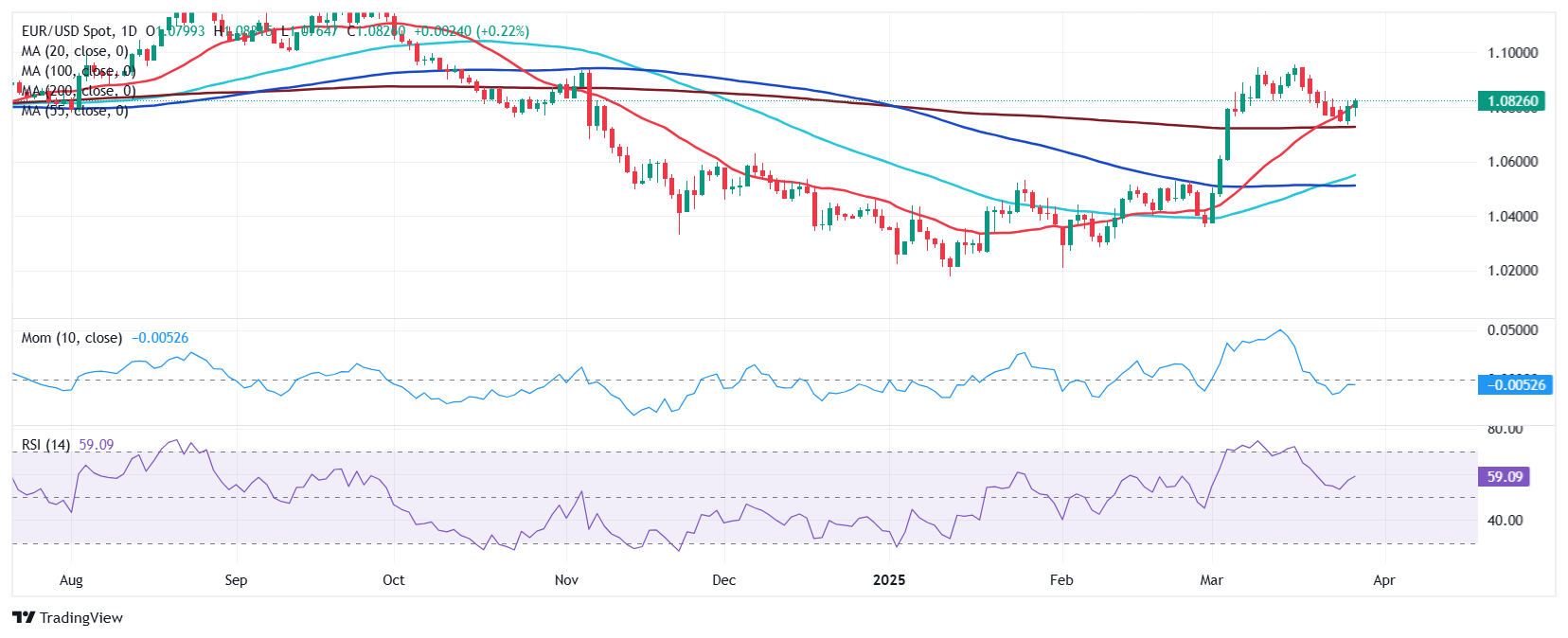- US President Donald Trump’s trade war and geopolitical matters fuel risk aversion.
- Eurozone economies show signs of life after persistent contraction.
- EUR/USD struggles to find its way, buyers are not ready to give up.
The EUR/USD pair remained under selling pressure for a second consecutive week but ended it little changed at around 1.0820. The US Dollar (USD) remained trapped between tariff-related concerns and tepid US data, limiting its safe-haven condition.
Trump gets into geopolitical matters
Market players kept their eyes on US President Donald Trump’s announcements throughout the week. Levies are indeed the main concern, but not the only one. The US President did not refrain from geopolitical matters and kept dealing separately with Russia and Ukraine to reach a ceasefire between the two nations.
Optimism surged on Wednesday amid the White House reporting that both countries agreed to ensure “safe navigation, eliminate the use of force, and prevent the use of commercial vessels for military purposes in the Black Sea.”
Ukrainian President Volodymyr Zelenskyy agreed to stop using military force in the Black Sea, but the Kremlin said it would only implement such an agreement when sanctions imposed on its banks and exports over its invasion of Ukraine are lifted, making the deal void.
But it is not just about the Russia-Ukraine war. Trump repeatedly threatened Denmark by saying the US would annex its territory of Greenland, claiming it is a national security matter and triggering fresh geopolitical tensions with the European nation.
The strategic region has recently seen an increase in sea traffic between Europe, Russia and the US due to ice melting in the Arctic. Additionally, the territory is rich in mineral oil and gas resources that remain sub-exploited, making it attractive to the US President.
The US menaced with sending a delegation to Greenland, which would include the White House national security adviser, Mike Waltz, but finally decided to visit the island’s US military base, Pituffik, de-escalating tensions with Greenland and Denmark authorities.
Tariffs affecting ECB’s decisions
Regarding tariffs, Trump came out mid-week announcing fresh levies on vehicles and auto parts coming into the US. Such taxes will be 25%, with tariffs on vehicles coming into effect on April 3, while those on auto parts are scheduled for May or later. Trump also announced that more tariffs could be imposed on the Eurozone and Canada.
Is it worth remembering that the US is the European Union’s (EU) most important trade partner, and local authorities can not ignore the threats to the Eurozone economic picture.
European Central Bank (ECB) member of the Governing Council, Pierre Wunsch, noted that tariffs are making the path ahead for ECB interest rates “more complicated,” adding that “If we forget tariffs ... we were going in the right direction.”
Earlier in the month, ECB President Christine Lagarde said that the US unleashed trade war could push EU inflation by half a percentage point, with detrimental effects on growth. With that said, the ECB seems not to have much more to do than to keep trimming interest rates.
Data releases fuel concerns
EU data was mostly encouraging, yet it fell short of attracting fresh buying interest. The Hamburg Commercial Bank (HCOB) released the preliminary estimates of the March Purchasing Managers’ Index (PMI). “German business activity rose at the quickest rate for ten months in March, amid a first increase in manufacturing production for almost two years,” according to the official report, with the manufacturing index printing at 48.3, up from the previous 46.5. The Services PMI, on the contrary, contracted to 50.2 from the 51.1 posted in February.
The EU Manufacturing PMI rose to 48.7 from the previous 47.6, while services output eased from 50.6 to 50.4. The EU Composite PMI posted 50.4, improving from the 50.2 achieved in February. On the price front, both input costs and output charges rose at slower rates.
Across the pond, S&P Global published the preliminary estimates of the March Purchasing Managers’ Indexes (PMIs). The official report states that US business activity growth picked up momentum in March “as a marked upturn in the service sector offset a renewed fall in manufacturing output.” The Composite PMI improved to 53.5 from 51.6 in February.
More worrisome, US consumer sentiment plummeted in March, as the Conference Board’s Consumer Confidence Index fell from 98.3 to 92.9, its weakest reading since February 2021.
Finally, the US published the February PCE Price Index, which held steady at 2.5% as expected. Core annual price pressures, however, rose to 2.8%, higher than the 2.7% expected and the previous. On a monthly basis, the PCE Price Index rose 0.3% as expected, while the core reading rose 0.4%, surpassing the 0.3% anticipated by market players.
The US Dollar ticked higher as an immediate reaction to the headlines but later changed course, as concerns about the US economic health sent investors away from the currency.
What’s next in the docket
In the upcoming days, Germany and the EU will publish the preliminary estimates of the March Harmonized Index of Consumer Prices (HICP). The US, in the meantime, will release the official March ISM Manufacturing PMI and the ISM Services PMI for the same month, alongside employment data.
February JOLTS Job Openings will be out on Tuesday, while the March ADP Employment Change report will be released on Wednesday. March Challenger Job Cuts and weekly unemployment figures will come next, ahead of the Nonfarm Payrolls report scheduled for Friday.

EUR/USD technical outlook
The EUR/USD pair weekly chart shows that it hovers around its latest opening, but also that it posted a lower low and a lower high, reflecting that selling pressure prevails. The same chart shows that a mildly bearish 200 Simple Moving Average (SMA) provided resistance, currently at around 1.0855. The 20 and 100 SMAs remain directionless, although below the current level, limiting EUR/USD bearish potential. Finally, technical indicators remain within positive levels, although the Relative Strength Index (RSI) indicator has lost directional strength and lies flat around 57.
The technical outlook is less clear according to the daily chart, but the downside seems well-contained. The EUR/USD pair met buyers at around a flat 200 SMA at 1.0730, while the 100 SMA remains directionless far below the longer one. As per the 20 SMA, it maintains its firmly bullish slope above the longer ones, with the price currently aiming to advance beyond it. The Momentum indicator is flat around its 100 line, failing to provide directional clues, while the RSI aims marginally higher at around 58.
Gains beyond 1.0855 expose the 1.0900 region, while beyond the latter, EUR/USD could extend gains towards the 1.1000 mark. On the contrary, a slide below 1.0730 exposes the 1.0630 area, with the next support level at 1.0580.

Nonfarm Payrolls FAQs
Nonfarm Payrolls (NFP) are part of the US Bureau of Labor Statistics monthly jobs report. The Nonfarm Payrolls component specifically measures the change in the number of people employed in the US during the previous month, excluding the farming industry.
The Nonfarm Payrolls figure can influence the decisions of the Federal Reserve by providing a measure of how successfully the Fed is meeting its mandate of fostering full employment and 2% inflation. A relatively high NFP figure means more people are in employment, earning more money and therefore probably spending more. A relatively low Nonfarm Payrolls’ result, on the either hand, could mean people are struggling to find work. The Fed will typically raise interest rates to combat high inflation triggered by low unemployment, and lower them to stimulate a stagnant labor market.
Nonfarm Payrolls generally have a positive correlation with the US Dollar. This means when payrolls’ figures come out higher-than-expected the USD tends to rally and vice versa when they are lower. NFPs influence the US Dollar by virtue of their impact on inflation, monetary policy expectations and interest rates. A higher NFP usually means the Federal Reserve will be more tight in its monetary policy, supporting the USD.
Nonfarm Payrolls are generally negatively-correlated with the price of Gold. This means a higher-than-expected payrolls’ figure will have a depressing effect on the Gold price and vice versa. Higher NFP generally has a positive effect on the value of the USD, and like most major commodities Gold is priced in US Dollars. If the USD gains in value, therefore, it requires less Dollars to buy an ounce of Gold. Also, higher interest rates (typically helped higher NFPs) also lessen the attractiveness of Gold as an investment compared to staying in cash, where the money will at least earn interest.
Nonfarm Payrolls is only one component within a bigger jobs report and it can be overshadowed by the other components. At times, when NFP come out higher-than-forecast, but the Average Weekly Earnings is lower than expected, the market has ignored the potentially inflationary effect of the headline result and interpreted the fall in earnings as deflationary. The Participation Rate and the Average Weekly Hours components can also influence the market reaction, but only in seldom events like the “Great Resignation” or the Global Financial Crisis.
Information on these pages contains forward-looking statements that involve risks and uncertainties. Markets and instruments profiled on this page are for informational purposes only and should not in any way come across as a recommendation to buy or sell in these assets. You should do your own thorough research before making any investment decisions. FXStreet does not in any way guarantee that this information is free from mistakes, errors, or material misstatements. It also does not guarantee that this information is of a timely nature. Investing in Open Markets involves a great deal of risk, including the loss of all or a portion of your investment, as well as emotional distress. All risks, losses and costs associated with investing, including total loss of principal, are your responsibility. The views and opinions expressed in this article are those of the authors and do not necessarily reflect the official policy or position of FXStreet nor its advertisers. The author will not be held responsible for information that is found at the end of links posted on this page.
If not otherwise explicitly mentioned in the body of the article, at the time of writing, the author has no position in any stock mentioned in this article and no business relationship with any company mentioned. The author has not received compensation for writing this article, other than from FXStreet.
FXStreet and the author do not provide personalized recommendations. The author makes no representations as to the accuracy, completeness, or suitability of this information. FXStreet and the author will not be liable for any errors, omissions or any losses, injuries or damages arising from this information and its display or use. Errors and omissions excepted.
The author and FXStreet are not registered investment advisors and nothing in this article is intended to be investment advice.
Recommended Content
Editors’ Picks

EUR/USD holds losses below 1.1400 ahead of ECB policy decision
EUR/USD stays on the back foot below 1.1400 in the European session on Thursday. The pair loses ground on the back of a broad US Dollar rebound and as traders remain cautious ahead of the European Central Bank interest rate decision and Lagarde's press conference.

GBP/USD stays defensive near 1.3250 as US Dollar bounces
GBP/USD stays defensive near 1.3250 in Thursday's European trading, snapping its seven-day winning streak. A tepid US Dollar recovery amid risk appetite prompts the pair to pullback from six-month highs of 1.3292 set on Wednesday. Traders look to tariff headlibnes and US data for fresh impetus.

Gold price retreats from record high as profit-taking kicks in
Gold price retreats after touching a fresh all-time peak earlier this Thursday and erodes a part of the previous day's blowout rally though the downside remains cushioned. A slight improvement in the global risk sentiment, bolstered by hopes of US trade negotiations, turns out to be a key factor undermining the precious metal.

European Central Bank set to cut interest rates again amid easing inflation and tariff uncertainty
The European Central Bank will announce its April interest rate decision on Thursday at 12:15 GMT. Markets widely expect the central bank to lower key rates for the sixth consecutive time. This time the ECB is set to deliver another 25 basis points (bps) cut after the April policy meeting.

Future-proofing portfolios: A playbook for tariff and recession risks
It does seem like we will be talking tariffs for a while. And if tariffs stay — in some shape or form — even after negotiations, we’ll likely be talking about recession too. Higher input costs, persistent inflation, and tighter monetary policy are already weighing on global growth.

The Best brokers to trade EUR/USD
SPONSORED Discover the top brokers for trading EUR/USD in 2025. Our list features brokers with competitive spreads, fast execution, and powerful platforms. Whether you're a beginner or an expert, find the right partner to navigate the dynamic Forex market.